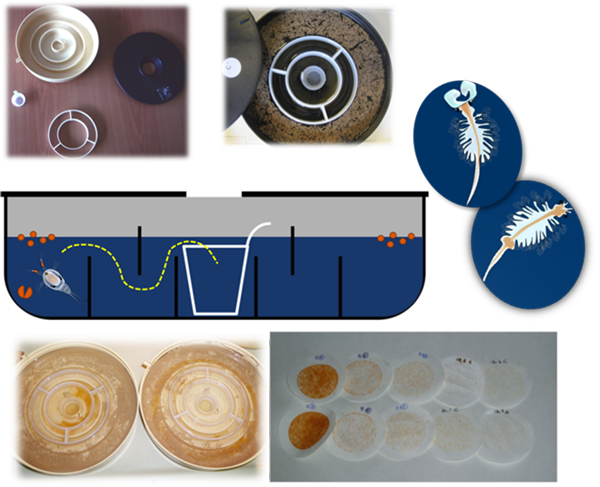Artemia ecotoxicity tests
Ecotoxicological assays are currently the most commonly used tool to evaluate the impact on biota of several kind of pollutants in the environment and to determine the effectiveness of certain species as bioindicator. The brachiopod crustacean Artemia sp. is one of the organisms most commonly used in ecotoxicology; it has been considered as a test organism since many years. In the 90s, in our laboratory Artemia acute and chronic toxicity tests have been developed and/or validated, they are now the standard tests currently in use. The hachting toxicity test (on Artemia cysts), developed in our laboratory in 1997, has been validated, together with the static acute and long-term mortality tests, by a national intercalibration exercise including 11 laboratories. Neverthess it is still underutilized, although it is cheap, easy to do and reliable. At the moment it is utilized to evaluate the impact of Diethylene glycol (DEG). DEG is an additive largely used during oil and gas exploitation process to prevent hydrate formation and corrosion events. It may be found within Produced Formation Water (PFW, the main discharge of the offshore platforms) and discharged directly into the sea. The work is performed in collaboration with Loredana Manfra, from ISPRA (Istituto Superiore Per la Protezione e la Ricerca Ambientale, Roma) and her work group.
Libralato G., Prato E., Migliore L., Cicero A.M., Manfra L. (2016) - A REVIEW OF TOXICITY TESTING PROTOCOLS AND ENDPOINTS WITH ARTEMIA SPP. Ecological Indicators, 69: 35-49. DOI: 10.1016/j.ecolind.2016.04.017
Artemia spp. is an historically popular biological model still requiring an official internationally based standardization. Several endpoints are currently available. Short-term acute endpoints include biomarker (acetylcholinesterase; heat stress proteins; lipid peroxidation; thiobarbituric acid reactive substances; thioredoxin reductase; glutathione-peroxidase; glutathione S-transferase; glutathione reductase; aldehyde dehydrogenase; and adenylpyrophosphatase and Fluotox), hatching (dry biomass, morphological disorders and size), behavioral (swimming speed and path length), teratogenicity (growth), and immobilization (meaning mortality after 5–30 s observation). Long-term chronic tests focus on growth, reproduction and survival or mortality after 7–28 d exposure from larval to adulthood stage. We analyzed each test looking at its endpoint, toxicant and experimental design including replicates, exposure time, number of exposed cysts or organisms and their relative life stage, exposure conditions during hatching and testing (salinity, pH, light intensity, aeration dilution media, and food supply), type of testing chambers, and quality assurance and quality control criteria. Similarities and differences between the identified approaches were highlighted. Results evidenced that hatching 24 h short-term and 14 d longterm mortality are the most promising Artemia spp. protocols that should go forward with international standardization.
Rotini A., Canepa S., Manfra L., Tornambè A., Migliore L. (2015) - CAN ARTEMIA HATCHING ASSAY BE A (SENSITIVE) ALTERNATIVE TOOL TO ACUTE TOXICITY TESTS? Bulletin of Environmental Contamination and Toxicology, 95(6): 745-751. DOI: 10.1007/s00128-015-1626-1
Artemia sp. is extensively used in ecotoxicity testing, despite criticisms inherent to both acute and long-term tests. Alternative endpoints and procedures should be considered to support the use of this biological model. The hatching process comprises several developmental steps and the cyst hatchability seems acceptable as endpoint criterion. In this study, we assessed the reliability of the hatching assay on A. franciscana by comparing with acute and long-term mortality tests, using two chemicals: Diethylene Glycol (DEG), Sodium Dodecyl Sulphate (SDS). Both DEG and SDS tests demonstrated a dose dependent hatching inhibition. The hatching test resulted more sensitive than acute mortality test and less sensitive than the long-term one. Results demonstrate the reliability and high sensitivity of this hatching assay on a short time lag and support its useful application in first-tier risk assessment procedures.
Manfra L., Savorelli F., Di Lorenzo B., Libralato G., Comin S., Conti D., Floris B., Francese M., Gallo M.L., Gartner I., Guida M., Leoni T., Marino G., Martelli F., Palazzi D., Prato E., Righini P., Rossi E., Migliore L. (2015) - INTERCALIBRATION OF ECOTOXICITY TESTING PROTOCOLS WITH ARTEMIA. Ecological Indicators, 57: 41-47. DOI: 10.1016/j.ecolind.2015.04.021
The brine shrimp, Artemia spp., is widely used in ecotoxicology as a target biological model. Although several protocols were available in the early 1980s, only the 24-h acute mortality toxicity test was evaluated in a European intercalibration exercise during that period. Nevertheless, documentation of standard methods serving to provide specifications, guidelines or detailed characteristics of the 24-h protocol is still unavailable. This paper present the results of an intercalibration study of three toxicity-testing protocols using Artemia franciscana: (a) the 24-h static acute mortality test, (b) the 48-h static hatchingtest and (c) the 14-d static-renewal long-term mortality test. A first tier of experiments was conducted by a reference laboratory, which investigated the repeatability of the three methods. The feasibility and reproducibility of these protocols were then investigated by an intercomparison exercise involving 11 participants for the acute mortality test, seven for the acute hatching test and nine for the long-termmortality test. Protocols were tested on reference toxicants (copper sulphate pentahydrate and sodiumdodecyl sulphate). The coefficients of variation were <20% and <50% for intra- and inter-laboratory activi-ties, respectively. These results encourage the standardization of the proposed methods and their use as regulatory procedures.